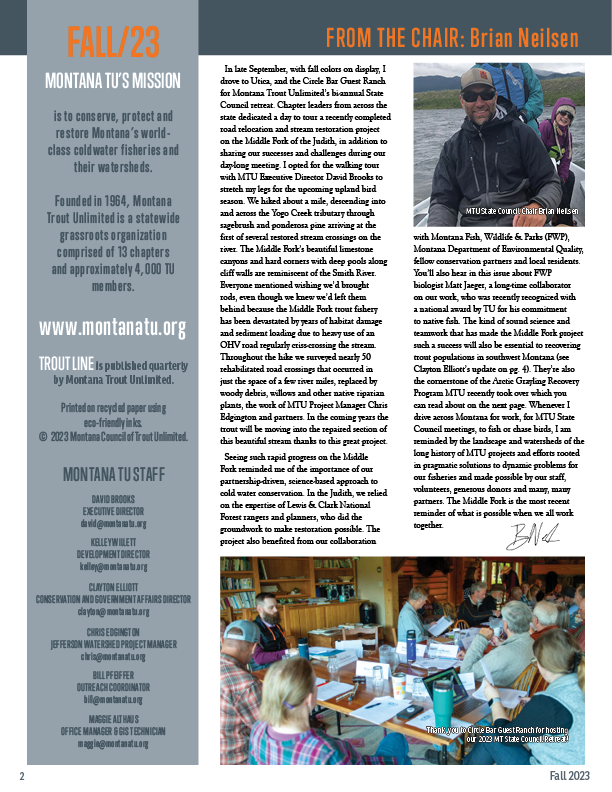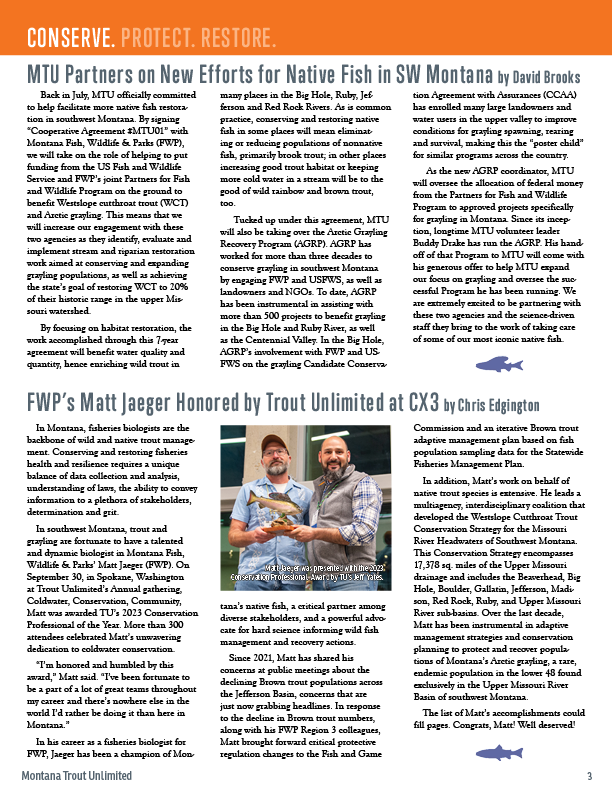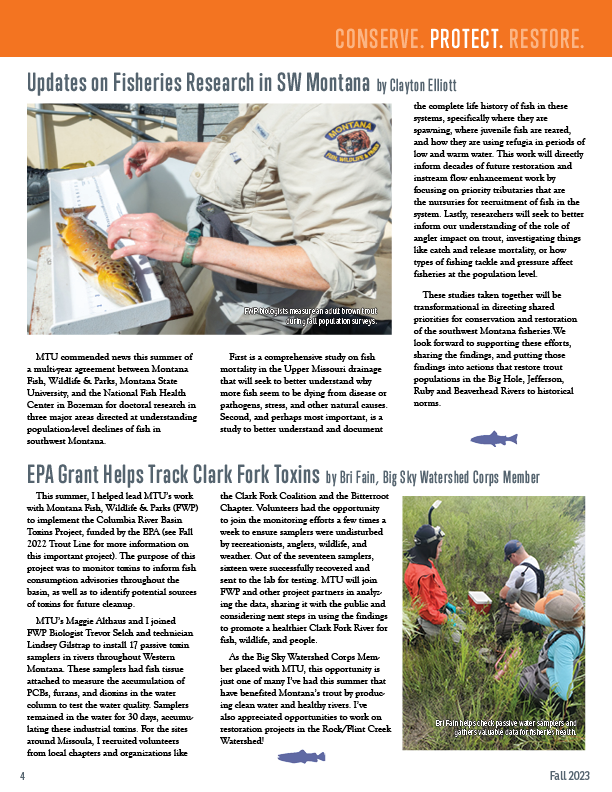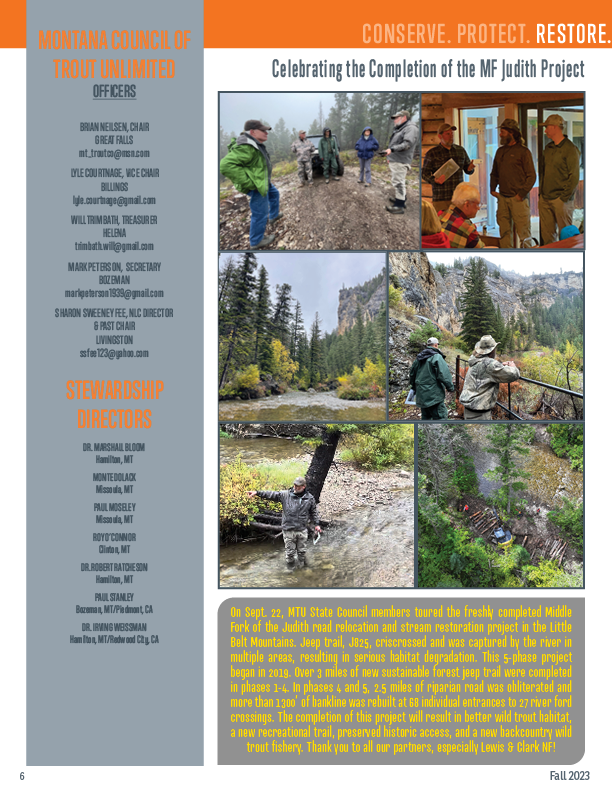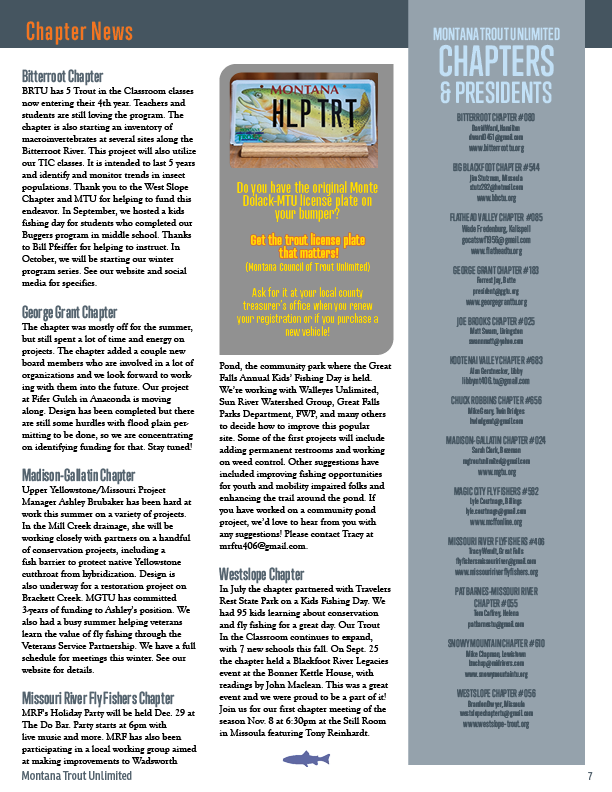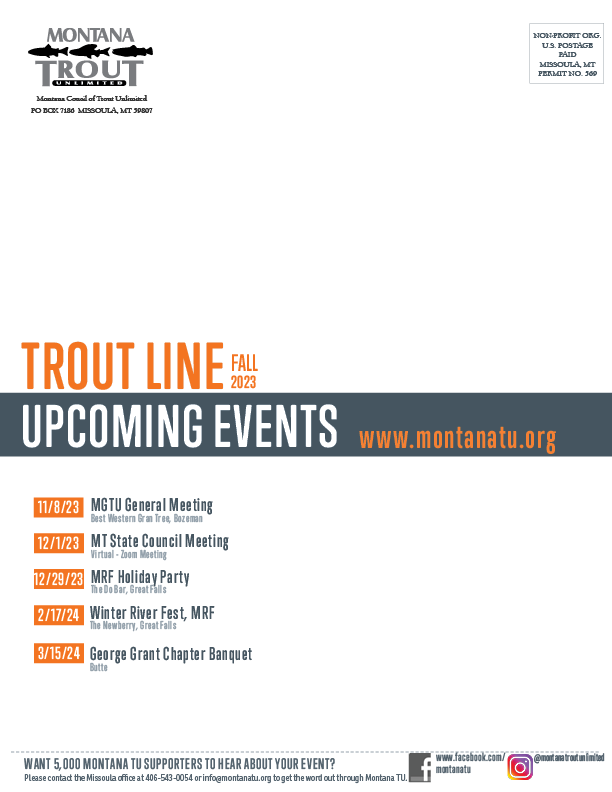Check out the latest issue of MTU’s Trout Line newsletter and our Annual Report for the 2023 fiscal year! Read it online here or download a PDF for your favorite reading device. To join our mailing list, email [email protected].
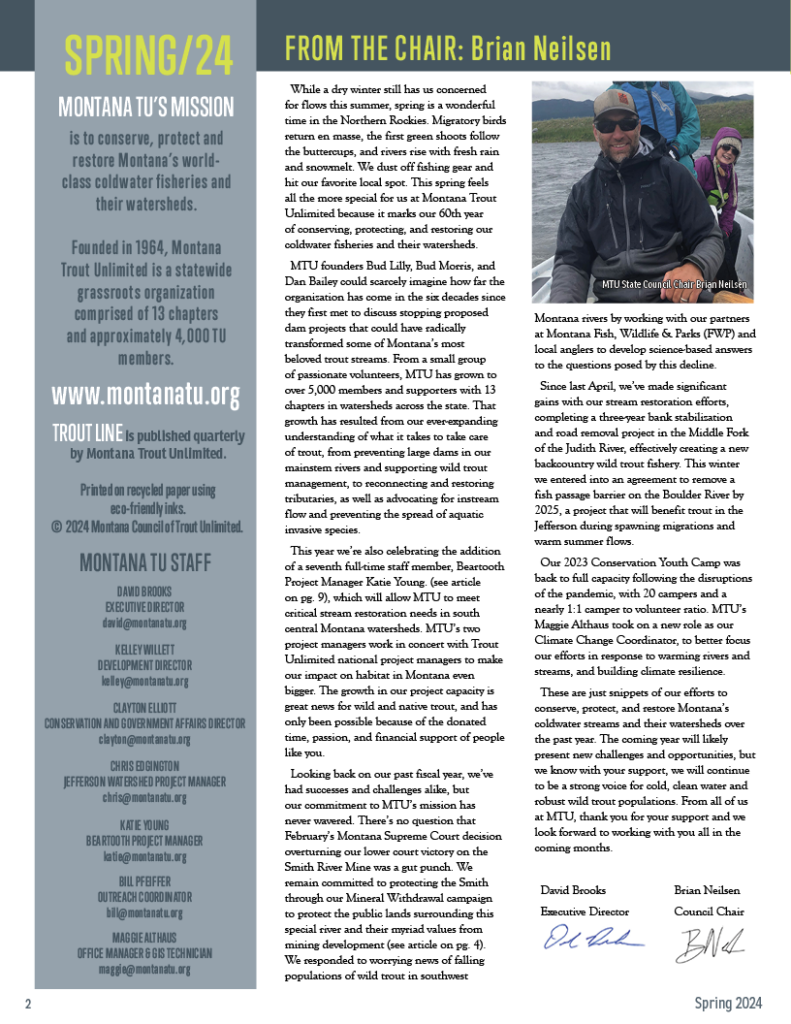

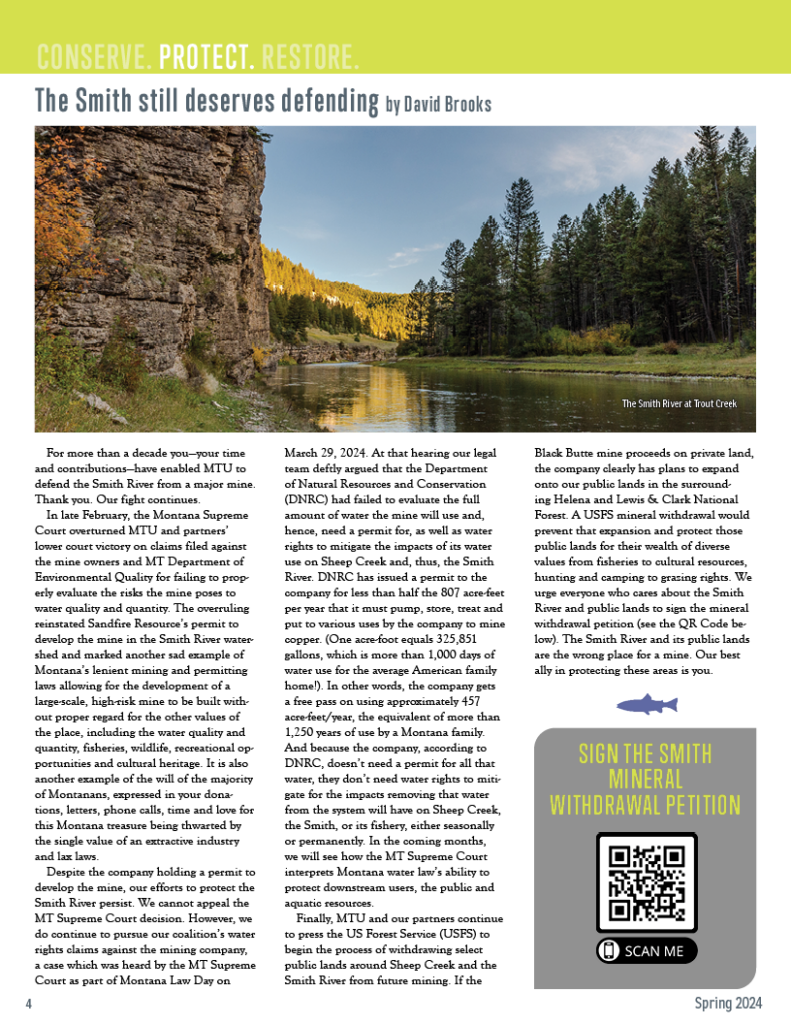
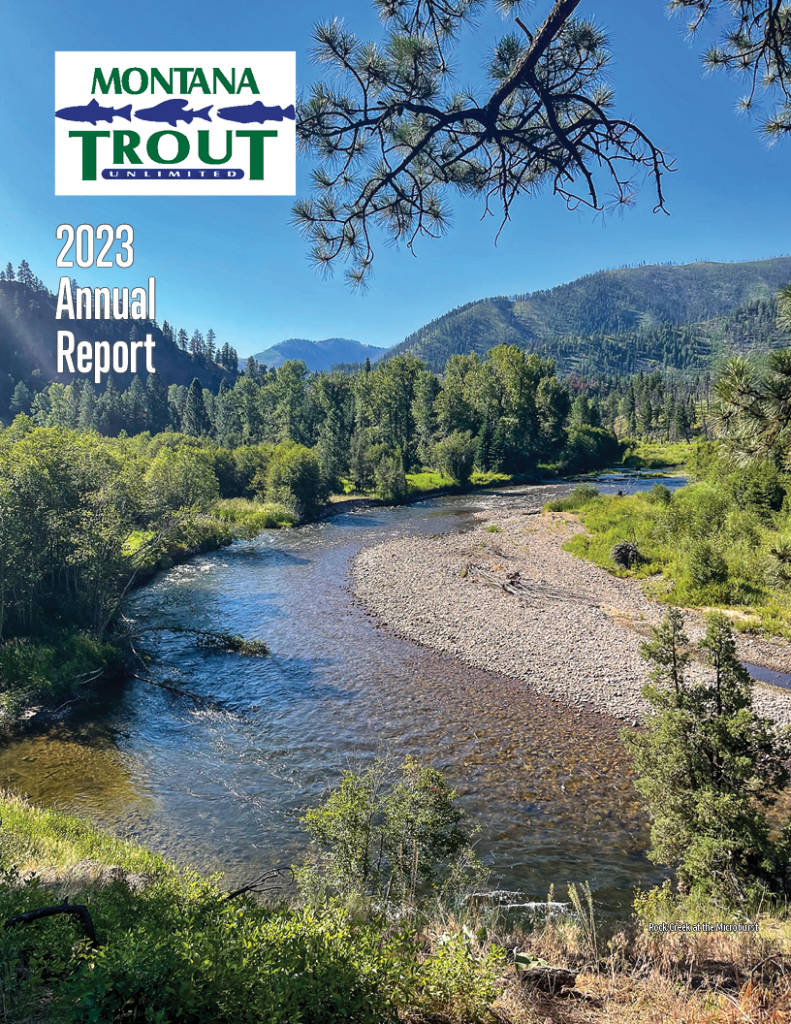
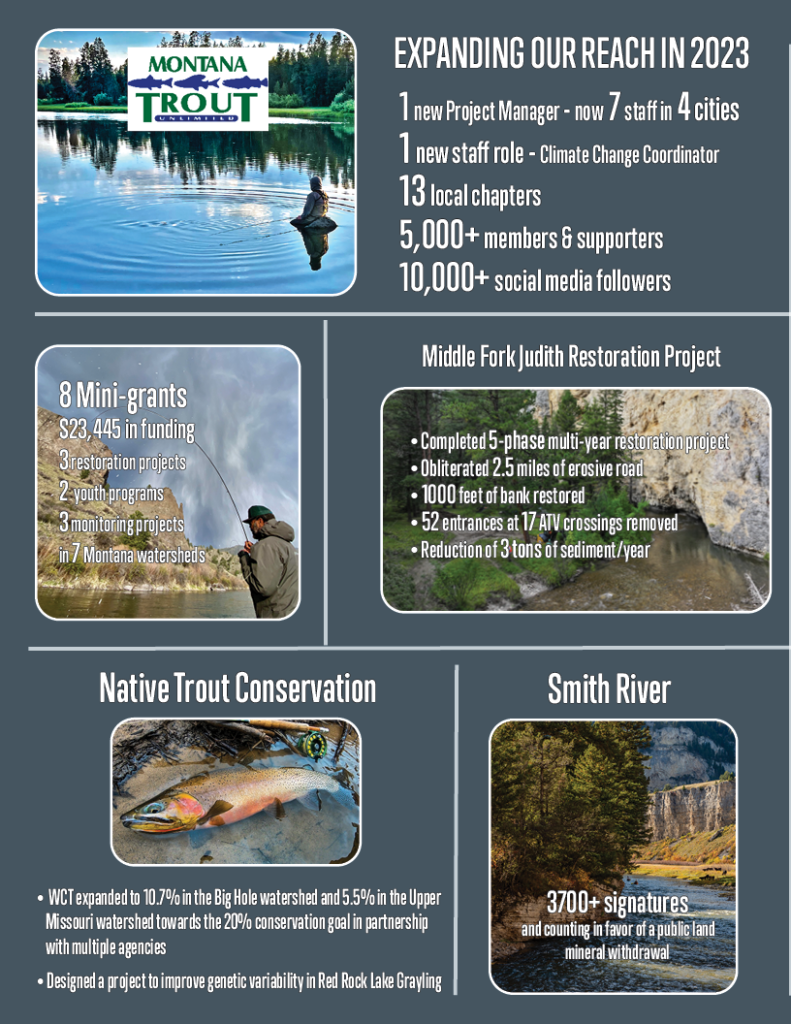
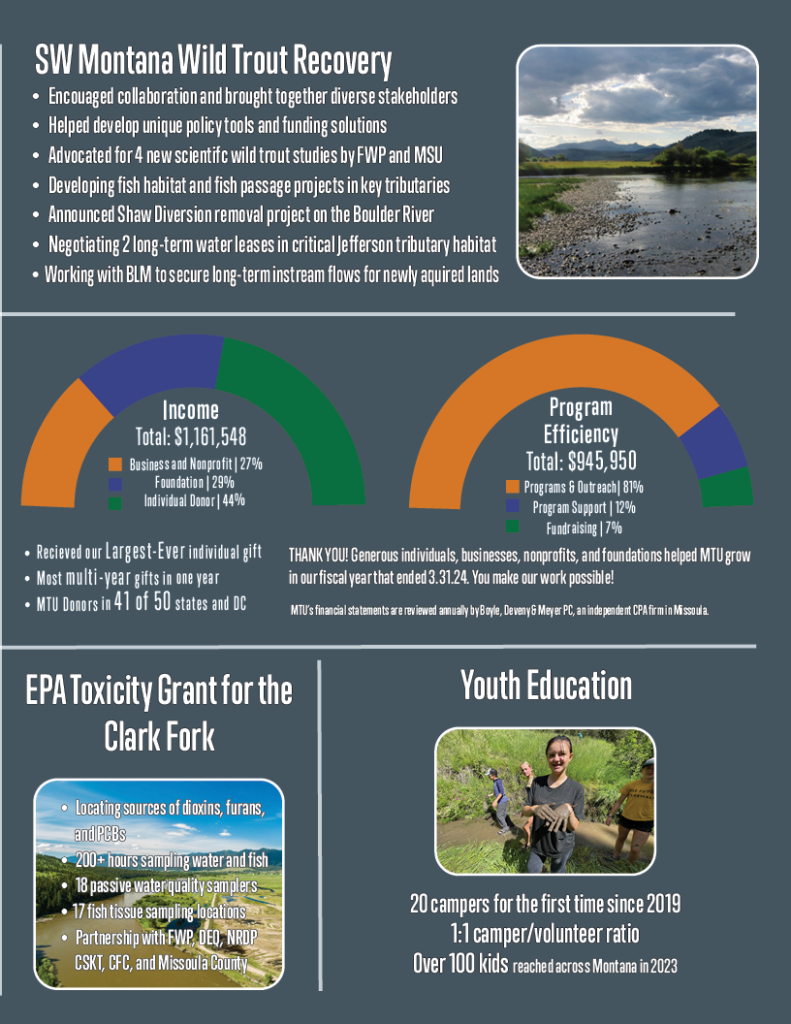
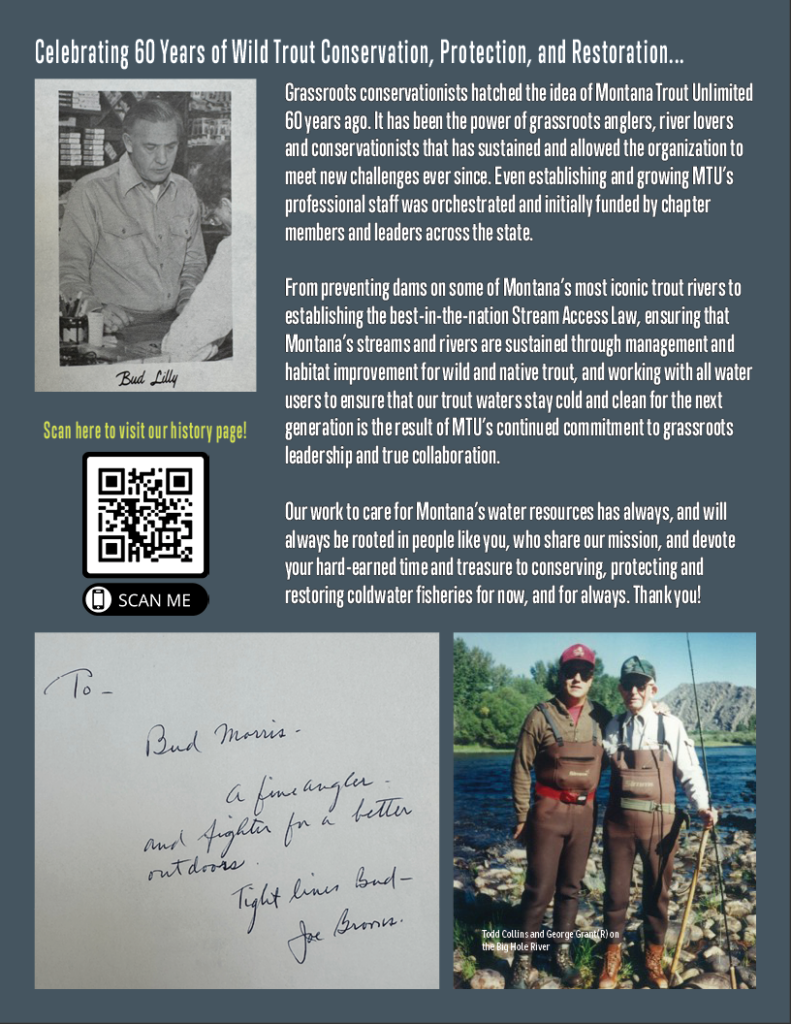


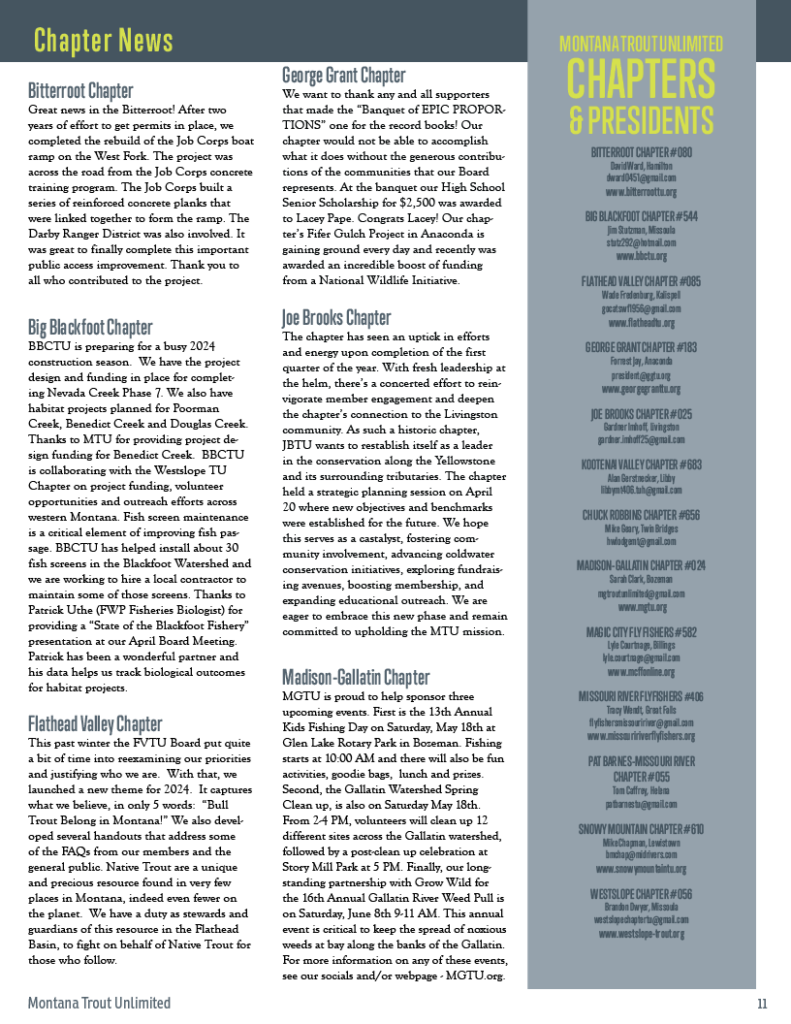
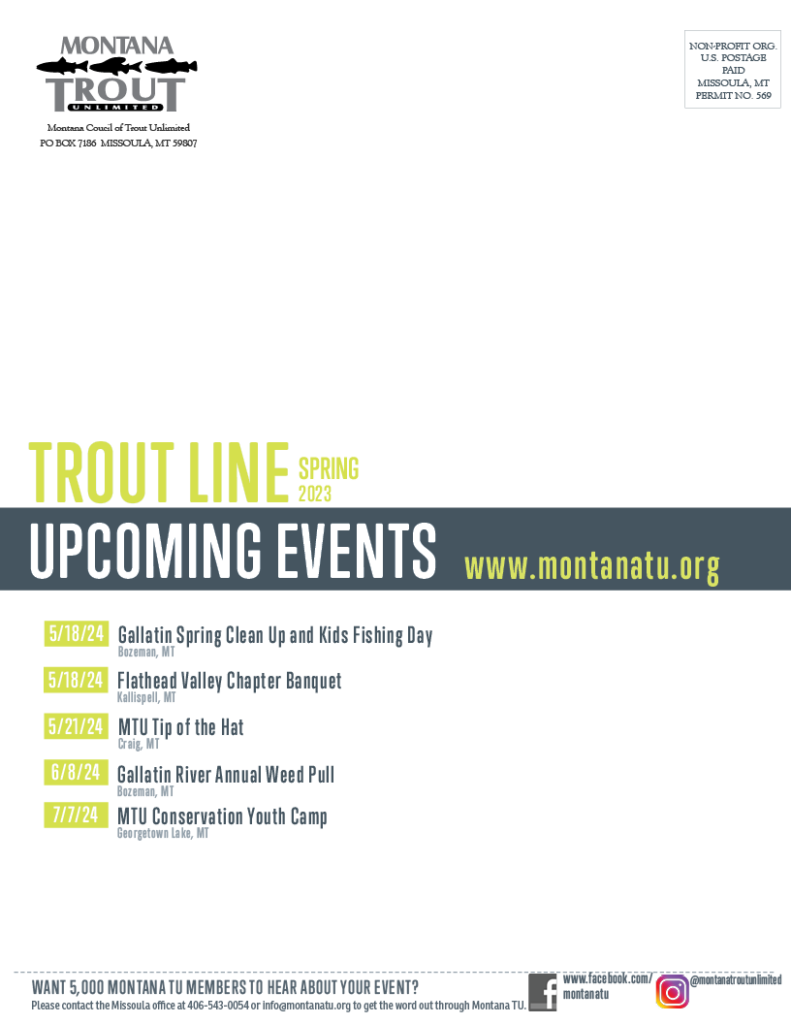

Check out the latest issue of MTU’s Trout Line newsletter and our Annual Report for the 2023 fiscal year! Read it online here or download a PDF for your favorite reading device. To join our mailing list, email [email protected].











What Climate Change Means for Trout Unlimited and Our Members
by Maggie Althaus, MTU Climate Change Coordinator
Dr. Helen Neville, Trout Unlimited’s Chief Scientist, is optimistic about the future despite the challenges posed by climate change. With nearly two decades of experience with Trout Unlimited, Dr. Neville emphasizes the importance of engagement and education in addressing the impacts of climate change on coldwater fisheries.
Dr. Neville, thank you for taking the time to talk to me today. Could you start by sharing a bit about your background and your work with TU?

HN: Certainly. I’ve been with Trout Unlimited for quite some time, initially joining as part of our national science team in 2006 and later assuming the role of Senior Scientist in 2018. My background is in ecology, evolution, and conservation biology, with a focus on conservation genetics. That’s a broad field but I have always focused on trout and salmon in my work even before coming to TU. I’m based in Boise, ID with a small core of TU science staff but we have science staff across the country.
As an outdoor enthusiast yourself, how have you seen climate change affect your experiences?
HN: Well, I think it stems from a deep-rooted love of nature that I inherited from my dad and our family culture. Growing up in a rural area of South Carolina, surrounded by mountains, ocean, fields and forests, I spent countless hours outdoors, exploring and fishing in North Carolina streams as a kid. Nature has always been a significant part of my life.
Initially, I was on a pre-med track in college, following the path to medical school. However, it was my doctor mother who encouraged me to consider other options that would allow me to combine my passion for science with my love of nature. This led me to focus on genetics, not in the context of human health, but rather in understanding how organisms interact with their environments and using genetic tools for conservation purposes.
While I don’t get to spend as much time outdoors as I’d like these days, I still enjoy hiking, biking, skiing, and camping whenever I can. But I can’t ignore the pervasive presence of climate change in the environments I cherish. It’s a constant concern, especially considering how disconnected many people, particularly younger generations, are becoming from nature.
Having two teenage daughters, I feel fortunate that they have opportunities to experience the outdoors, although it’s becoming increasingly challenging with the impacts of climate change. Planning camping trips now involves careful consideration of smoke conditions and fire risks, which have become all too common in the West. Last year, Boise had a relatively fortunate season, but many other areas were severely affected by smoke. It’s a reality we can’t ignore.

Why is conserving trout species and their habitats important not only to anglers but also to broader communities?
HN: Understanding the unique significance of native fish species can be challenging for the general public and even for anglers. But they have extraordinary history and broader importance on various fronts. For example, much of my past work has been on Lahontan cutthroat trout in the northern Great Basin Desert. Previously, it was thought that most of the diversity among cutthroat trout was shaped during the Pleistocene, within the last several 100,000 years or so. In 2018, however, there was a significant effort by the American Fisheries Society to update the phylogeny and taxonomy of cutthroat trout. This endeavor revealed that cutthroat trout trace back to a 10-million-year-old ancestor found in the Great Basin through a fossil discovered near Reno, and other evidence suggested the current lineages started forming several million years ago.
Resetting the clock back by millions of years underscores the importance of conserving these fish. They’ve evolved intricately to adapt to their landscapes. Each form embodies the unique heritage of its geographic region, carrying with it the history of its environment over millions of years.
Conserving biodiversity is paramount for preserving these connections. Native trout fulfill distinct ecological roles that non-native fish cannot replace. They are integral to the interconnected web of ecosystems, playing vital roles in maintaining ecological balance.
Moreover, native trout hold significant cultural importance, not just for anglers but also for Tribes and other communities with deep-rooted relationships with fish. Protecting these species safeguards cultural heritage and ecological integrity for generations to come.
Climate change is a major threat to trout habitat. How much of an impact will this have on native species?
HN: The impact of climate change on trout populations is and will be tremendous. Climate change is causing dramatic shifts, including increased flow events, extreme precipitation, rain on snow, declining snowpack, and more frequent wildfires.
Scientists have made a lot of predictions regarding the future niches that trout may occupy based on factors like temperature and flow changes. Now, we’re witnessing some of these predictions coming true, with habitat shrinking and streams becoming warmer and more intermittent, especially in the dry interior West. Non-native species expansion, in part related to climate change, is also a major threat. Excellent recent science shows that the distributions of both bull trout and cutthroat trout have declined and are predicted to decline further, but the drivers differ somewhat: temperature and changes in flow are driving bull trout impacts, whereas for cutthroat trout the climate-related impact of non-native trout has been the primary cause of declines.
While scientists are still working to gather data on how trout are responding, it’s clear that many populations are struggling to cope with these challenges.
It’s crucial to recognize that trout and salmon evolved in landscapes characterized by dynamic events like floods and fires. However, human-induced changes have significantly altered these environments and the buffering mechanisms trout and salmon have to handle these impacts. Small, isolated trout populations now face reduced resilience, as they cannot utilize strategies evolved over time to adapt to change. Isolation leaves them vulnerable during environmental events, with no nearby sources for recolonization.
Moreover, isolation affects their genetics, making them less resilient. The introduction of non-native trout species across the West exacerbates this issue because these fish compete and hybridize with native populations, further eroding their genetic integrity and ability to cope with change.
One important point to emphasize, though, is that although we know that climate change is a major threat with serious impacts, to date it is not the primary cause of extinction. The massive declines in biodiversity to date are driven largely by habitat loss, degradation and fragmentation – and for trout and salmon the effects of non-native species. To me, as sad as this is it also presents a major opportunity, to work to reverse the legacy of more traditional impacts we’ve had on fish habitat through restoration and smart management.
With 2023 being the hottest year on record, how do rising temperatures affect trout and their habitats?
HN: Trout have what’s known as a thermal niche, meaning they thrive within a specific range of temperatures. They are “cold water fish” so rely on clean, cold water, of course, but warm temperatures aren’t always detrimental for trout; in fact, some warmth at certain life stages can be beneficial, aiding their growth. However, there’s a delicate balance. Temperatures that are too cold can hinder reproduction and growth, especially if the growing season is short or their metabolism isn’t adapted to colder conditions. On the other hand, if temperatures exceed a certain threshold, it becomes stressful for them and can become lethal.
As cold-water fish, trout have a somewhat narrow (colder) temperature range, though that varies somewhat among species. For example, bull trout and char need cold water more than European brown trout, which are nonnative to the region (this is one reason non-native species invasion can be driven in part by climate change). When temperatures reach stressful points, trout may stop growing to focus on survival. Similarly, excessive warmth can lead to physiological stress, such as protein breakdown and heat stress responses, and their metabolism works overtime to cope with the warm water.
Both acute and chronic temperature changes can be harmful. Acute increases above a critical threshold can be immediately lethal, while chronic exposure to suboptimal temperatures over time can weaken trout, making them smaller and less productive, and more susceptible to diseases and other stressors. Finding the right balance within their thermal range is crucial for their growth and survival – and is why maintaining large, interconnected habitats that let them access different temperatures throughout their life is so crucial.
What gives you optimism for the future of coldwater fisheries in the face of climate change?
HN: To be honest, it’s hard to have a lot of optimism in the face of climate change. As a scientist, knowing what lies ahead can be daunting. However, what does give me hope is the immense opportunity we have to restore the damage we’ve inflicted on the landscape – focusing on those more ‘traditional’ impacts of habitat degradation and fragmentation I mentioned before that are currently driving much of the decline.
Earlier, I mentioned some of the research we’ve conducted to project the impact of climate change on species like cutthroat trout. By examining their environmental niche—such as temperature and flow ranges—we can forecast where they might be in the future given certain climate scenarios. These projections are often grim, but they’re also based on current data and observations, which already indicate significant challenges. Many of these species are already at risk and even listed under the Endangered Species Act due to their current precarious status. However, I see this as an opportunity.
While we can’t control all aspects of climate change, we can work to reverse some of this legacy damage to improve how our ecosystems handle and adapt to changing conditions. This includes initiatives like tree plantings, restoring riparian habitats, reconnecting fragmented systems, improving flows and eradicating non-native species. These efforts hold tremendous potential for positive impact.
In addition to supporting those projects, what advice would you give to someone, especially young people, facing climate change?
HN: Well, that’s a significant question, especially considering how much of the burden of this issue falls on the shoulders of young people. My advice would be to get engaged. Educate yourself and others.
I believe younger generations have a unique opportunity to influence older ones who may not fully grasp the urgency of climate change. Many older individuals have shared how their perspective shifted after conversations with their grandchildren or children, who emphasized the reality and seriousness of the issue. So, while the burden shouldn’t solely rest on young people, they can play a crucial role in sparking change. It’s essential to have conversations with family members, grandparents, and anyone who will listen. Climate change messaging needs to come from diverse sources to resonate effectively. Hearing about its impacts from different perspectives can be incredibly impactful.
TU’s Climate Change Working Group focuses a lot on messaging, and I can’t stress enough how crucial it is for people to talk about climate change. Even in families where it’s not commonly discussed, having a young person bring it up and share their experiences can make a significant difference in raising awareness and driving action.
From a TU perspective, there are numerous opportunities to get involved. Whether it’s tree planting, planning restoration or stream reconnection projects, or working on policy and advocacy, there are plenty of ways to make a difference.
I feel incredibly fortunate to work for TU. It’s an organization comprised of outdoor enthusiasts, anglers, and nature lovers who share a deep connection with the environment, much like yourself. Do you think this aspect makes TU unique?
HN: I believe so. We’re not just a group of fishing enthusiasts; we’re deeply committed to conservation. Our staff are amazingly passionate and mission-driven, and there’s a deep culture within TU grassroots that encourages involvement and engagement – as is obvious from your position! Whether it’s through education, restoration projects, or advocacy efforts, there are numerous ways for members to make a meaningful impact.
I have immense respect for TU members because they invest their passion, time, and expertise into meaningful engagement. It’s fascinating to see how this culture of involvement has influenced our messaging, particularly regarding climate change. For instance, the Executive Director of Michigan Trout Unlimited, who is also a scientist, published a review several years ago of TU’s approach to climate change messaging. It highlighted how our culture of engagement and the expectation of member involvement have helped ground our messaging in tangible actions and impacts, especially through our on-the-ground projects. I just love that paper and use that emphasis all the time in my outreach.
Thank you for sharing your insights, Dr. Neville. Is there anything else you’d like to add?
HN: Mainly, thank you. Taking on this role as the Climate Change Coordinator for MTU and your efforts to share this crucial information to the public is tremendous. This is how we drive change—through awareness and action. The more we engage in conversations and share this knowledge, the greater impact we can have.
We are currently presented with a historic opportunity, particularly with the substantial infrastructure funding being directed towards on-the-ground initiatives in the West aimed at enhancing habitat resilience. There’s an abundance of work to be done, and ample resources available to support these efforts.
I encourage everyone to reflect on their passions and skills and consider how they can contribute meaningfully on-the-ground. With organizations like TU and others, there are countless avenues for involvement. So, thank you for all the work you’re doing for Montana TU and for prioritizing this focus.

Check out the latest issue of MTU’s Trout Line newsletter! Read it online here or download a PDF for your favorite reading device. To join our mailing list, email [email protected].
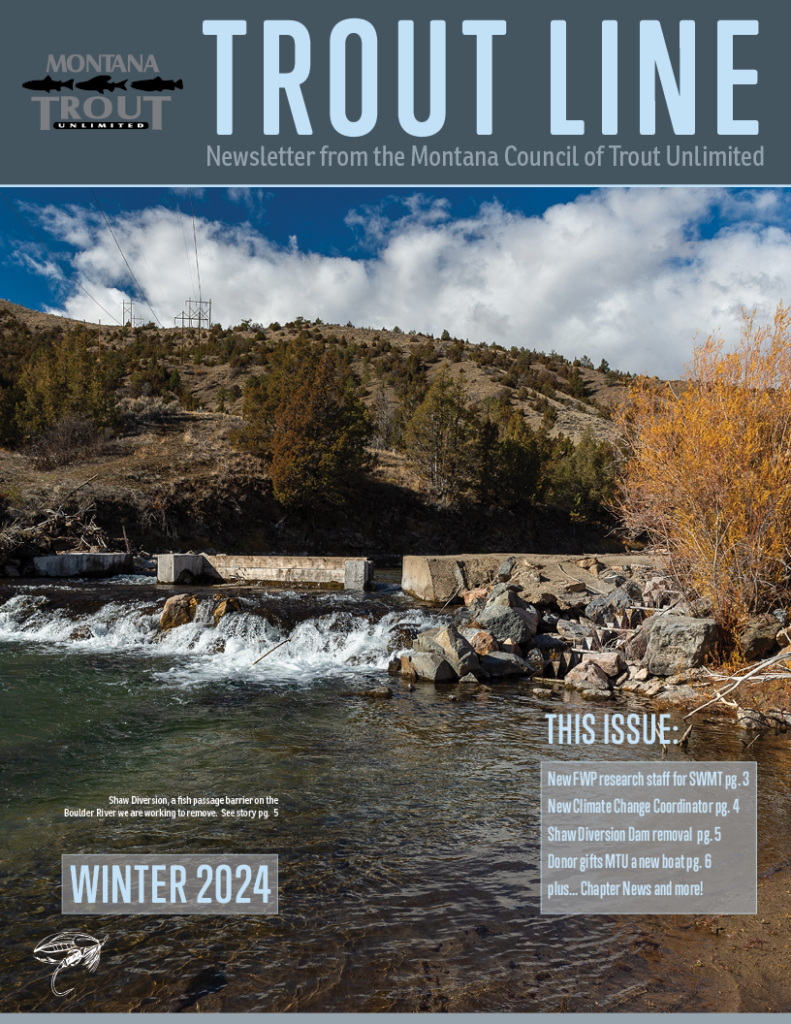
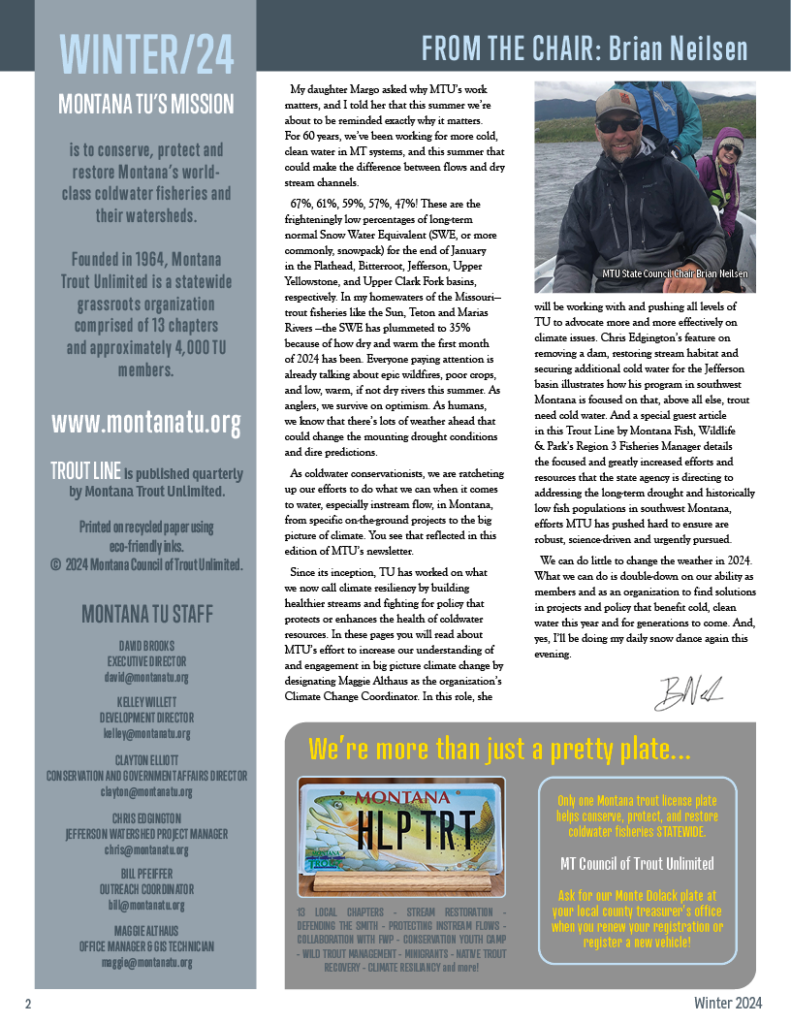
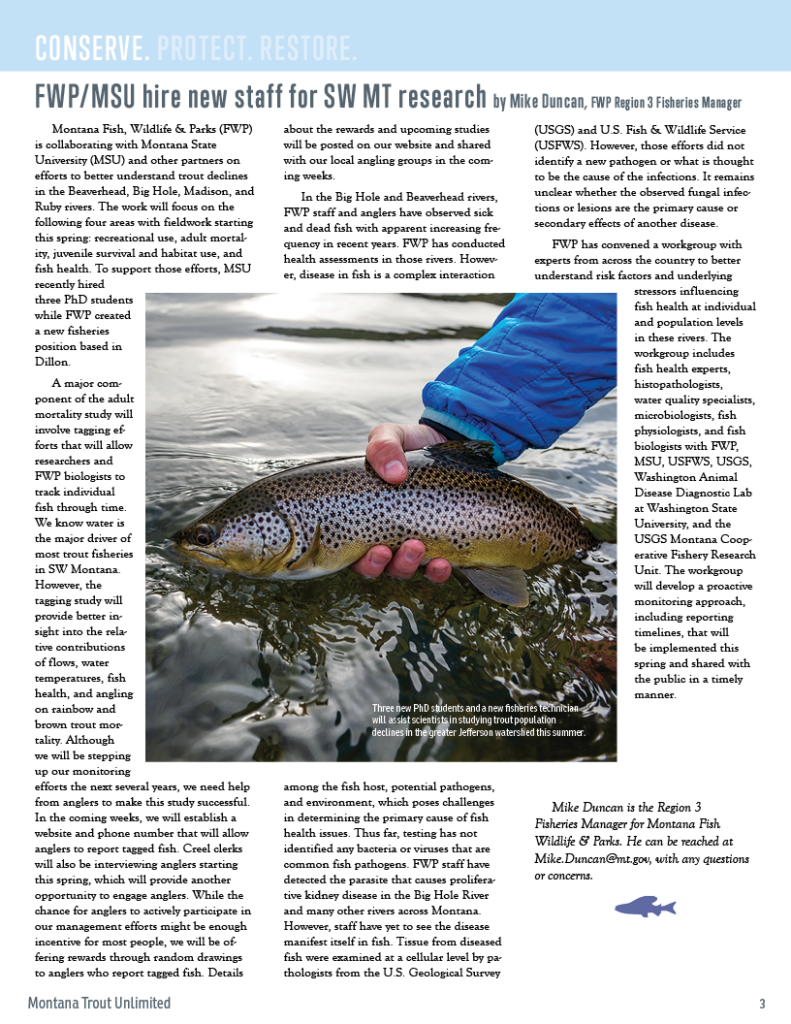
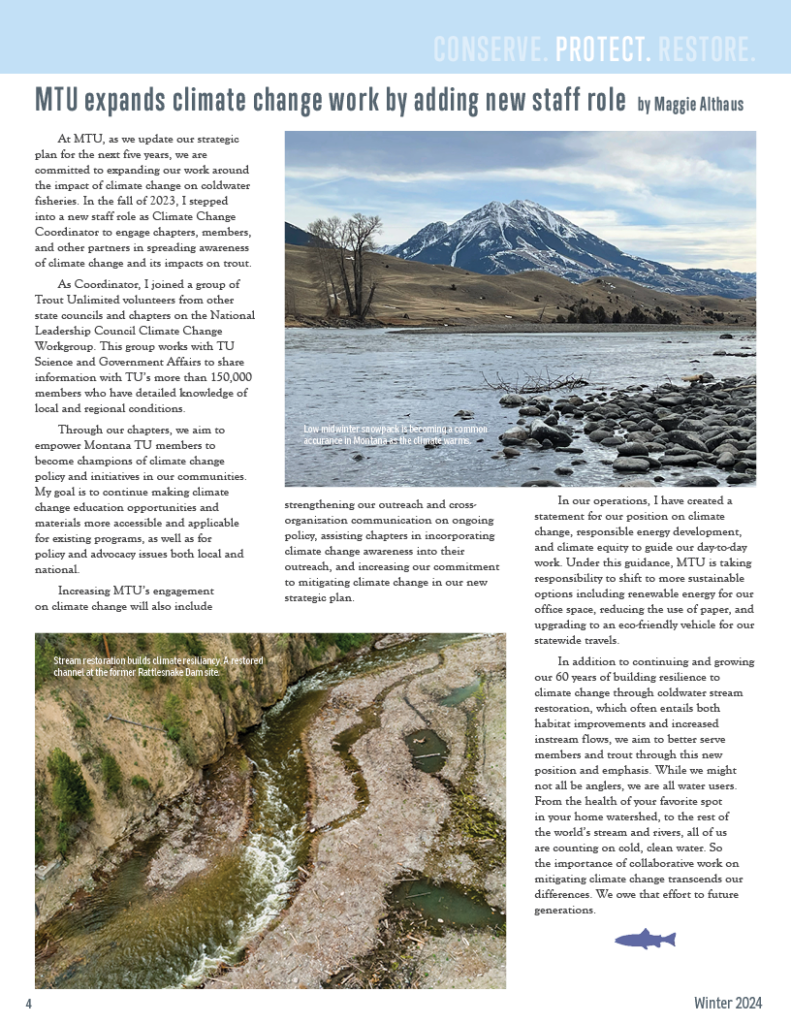


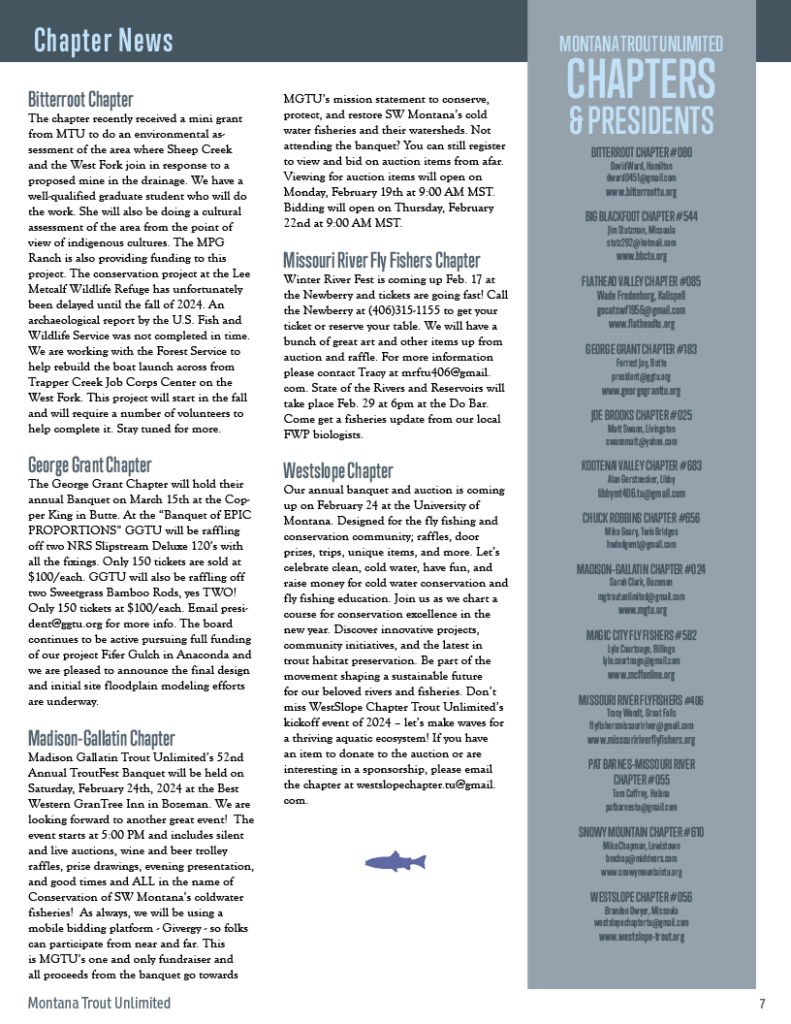

By Kelley Willett
I never had the good fortune to meet him, but I know that Farnum Alston fished all over the world. His friendships and achievements also span the globe. Farnum’s resume lists a plethora of accomplishments that are a testament to his lifelong commitment to public service and environmental protection.
I know all of this because one of his friends (a past MTU volunteer who has also given time and treasure to MTU) reached out to MTU after his death and together with Farnum’s widow, decided to honor his memory and make a big difference for Montana Trout Unlimited. They wanted his abundant fishing gear and drift boat to raise funds for cold-water conservation in Montana. As ever, MTU, is humbled when people think of us during the hardest of times.
Each year MTU hosts friends and donors on float trips to highlight the great work that their philanthropy makes possible. The aim is to show impact, and hopefully that results in more philanthropy. We’ve been rowing folks down the river in a very well-loved, two-decade old drift boat that has seen better days. Last year a staff member was ejected when a seat broke; we’ve been questioning if the boat is still safe for tours. We would not want to use donor funds to buy a new craft, which is why the gift of this beautiful, safe, comfortable boat is such a boon. We know that when people see the work, and the fish, and the repaired riparian corridors, that they want to continue giving, and in many cases give even more. A day on the water gives us the perfect place to also take about our policy, advocacy and education efforts that also benefit MT’s coldwater fisheries. We are excited to put a plaque in the boat recognizing this family for helping us and honoring this anglers’ legacy.
Fifty years from now, someone will be fishing a reach of a Montana river that was dear to this angler, and that will be thanks to his friend and his widow having the vision to honor his memory with a gift that truly keeps on giving.
To make a gift in Farnum’s memory, please consider Montana Trout Unlimited, which conserves, protects and restores the very Montana cold-water fisheries that he loved.
Checks can be mailed to: MTU, PO Box 7186, Missoula, MT 59807, or give online at www.montanatu.org.
ABOUT MONTANA TROUT UNLIMITED
Montana Trout Unlimited (MTU) represents more than 4,200 members and supporters organized into 13 chapters in Montana. We are a small, dedicated, creative staff tasked with overseeing our mission to conserve, protect, and restore Montana’s coldwater fisheries and their watersheds. MTU fulfills this mission through staff and volunteer-led outreach and education, fundraising, policy development, and science-driven stream restoration.
For more than two decades, MTU has regularly partnered with our national Trout Unlimited project managers and other stakeholders on streamflow and habitat restoration work across the state. Our work focuses on restoring instream flow, fish passage, and improving habitat for the benefit of native and wild trout populations in the Clark Fork, Missouri, Gallatin, Madison, Jefferson, Yellowstone, and many major tributary rivers and streams. In all of these geographies, we work collaboratively with federal and state agencies, as well as other nonprofit partners and businesses on federal, state, and private land-based projects. MTU is now interested in dedicating a project manager to evaluate and execute priority projects of this nature in the Yellowstone watershed, with a strong emphasis on Custer-Gallatin National Forest lands in the vicinity of Red Lodge, MT. This position will focus on inventorying, prioritizing, developing and implementing projects in the tributaries and mainstem of Rock Creek, East and West Rosebud, and the Stillwater River, as well as other prioritized streams. Thus, MTU is seeking qualified applicants to fill the newly created Custer-Gallatin Forest Project Manager position.
POSITION SUMMARY
TU Project Managers hold unique and diverse positions depending on the needs and opportunities in different watersheds. In short, people in these positions “make things happen on the ground.” In that spirit, we are hiring a self-motivated and highly capable person to identify, plan, and implement water conservation, fish passage, and stream and riparian restoration projects to benefit aquatic resources and fish populations primarily on streams in and adjacent to the Custer-Gallatin National Forest. The Project Manager will work closely with the USFS Custer-Gallatin staff to seek opportunities to reconnect coldwater sources to mainstem rivers and restore or create more resilient coldwater habitats on public lands. The Project Manager will be responsible for all aspects of this work from engaging relevant partners to inventory this geography for needed and potential projects, through project planning, permitting, contracting, implementation, monitoring and outreach. In addition to working with forest service staff, this position will also engage other TU staff, TU chapter volunteers and chapters, and partner organizations working in these watersheds. Experience with stream restoration, contractor oversight, and hydrology are key qualifications. Excellent interpersonal skills and communications –verbal and written – are a must, as is a high level of motivation to pursue the MTU mission.
A significant focus will be placed upon partnership-building with the Custer-Gallatin Forest and MT Fish, Wildlife and Parks, as well as the nearby Magic City Flyfishers chapter of TU (Billings) and the Joe Brooks chapter of TU (Livingston). Engaging local land trusts, conservation districts, state and federal agencies, landowners, watershed groups, and other non-profit organizations will also be key to success in this role. In addition, the successful applicant will be expected to seek out, apply for, and obtain funding to support project work and core operational costs. The Project Manager will work closely with other TU Project Managers in the state to obtain experience and coordinate efforts. Ideally the successful candidate will live and work from Red Lodge, MT, or the surrounding area. This position will require frequent local travel for field work.
When you join MTU, you will become part of a highly supportive community of coworkers who believe in collaboration, respect and sharing inspiration, as well as being committed to our core values: Science, Native and wild trout, Connectivity and Diversity. MTU is committed to working toward justice, equity, diversity, and inclusion both within our organization and in our work with people outside the organization.
DUTIES AND RESPONSIBILITIES
This is not an all-inclusive list of duties and responsibilities.
QUALIFICATIONS
COMPENSATION
Estimated salary for this position is $60-65,000 annually, depending on experience. MTU also provides an exceptional comprehensive benefits package including: health care, flexible spending account, employer match retirement 401(b), holidays and accrued paid time off, sick time, sabbatical, and other life/work balance benefits.
HOW TO APPLY
Please upload a one- to two-page letter of interest, resume, three professional references, and less-than-one-page answers to the supplemental questions (below) to TU’s Paylocity Site by Dec. 15, 2024. Interviews will be in early 2024. Winter, 2024, start date is flexible.
SUPPLEMENTAL QUESTIONS:
To assist MTU in evaluating your application, please answer the following questions. Please make your answers concise yet specific and keep them to under one page, single-spaced.
MTU is an Equal Employment Opportunity & Affirmative Action Employer pursuant to Section 503 of the Rehabilitation Act & Vietnam Era Veterans Readjustment Assistant Act.
MTU hires staff without regard to race, color, religion, national origin, age, gender, sexual orientation, marital status or disability.
Check out the latest issue of MTU’s Trout Line newsletter! Read it online here or download a PDF for your favorite reading device. To join our mailing list, email [email protected].
